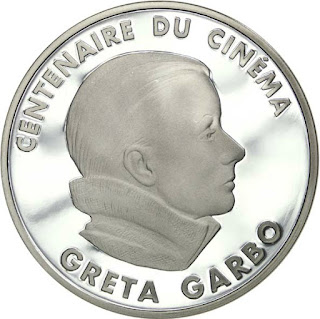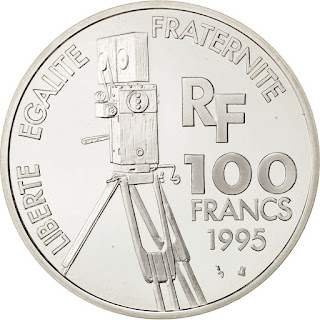France 100 Francs Silver Coin 1995 Greta Garbo
Commemorative issue: 100th Anniversary of Cinema
Obverse: Profile portrait of Greta Garbo.
Lettering: CENTENAIRE DU CINÉMA GRETA GARBO
Engraver: Atelier de Paris.
Reverse: Lumière Cinématographe Camera (Cinématographe Lumière at the Institut Lumière, France)
Lettering: LIBERTÉ ÉGALITÉ FRATERNITÉ RF 100 FRANCS 1995
Edge: Smooth.
Value: 100 Francs.
Metal: Silver (.900).
Weight: 22.2 g.
Diameter: 37 mm.
Thickness: 2.2 mm.
Shape: Round.
Commemorative coins of France
100th Anniversary of Cinema
Charlie Chaplin Greta Garbo Romy Schneider
Greta Garbo
Greta Garbo, original name Greta Lovisa Gustafsson (born September 18, 1905, Stockholm, Sweden — died April 15, 1990, New York, New York, U.S.), one of the most glamorous and popular motion-picture stars of the 1920s and ’30s who is best known for her portrayals of strong-willed heroines, most of them as compellingly enigmatic as Garbo herself.
The daughter of an itinerant labourer, Greta Gustafsson was reared in poverty in a Stockholm slum. She was working as a department-store clerk when she met film director Erik Petschler, who gave her a small part in Luffar-Petter (1922; Peter the Tramp). From 1922 to 1924 she studied at the Royal Dramatic Theatre in Stockholm, and in 1924 she played a major role in Gösta Berlings Saga (“The Story of Gösta Berling”). The film’s director, Mauritz Stiller, gave her the name Garbo, and in 1925 he secured her a contract with Metro-Goldwyn-Mayer in Hollywood.
At first, MGM chief Louis B. Mayer was skeptical of Garbo’s talent, but he and all studio executives were impressed by the initial rushes of her first American film, The Torrent (1926). Garbo projected a luminous quality that was perfect for silent pictures, motivating Mayer to sign her to an exclusive contract and raise her salary even before she completed work on this film. Throughout the remainder of the decade, Garbo appeared in such popular romantic dramas as Flesh and the Devil (1927), Love (1927), A Woman of Affairs (1928), and The Kiss (1929). She often costarred with John Gilbert, with whom she was romantically involved offscreen. Garbo’s success during this stage of her career was based not only on her mysterious, ethereal screen persona, but also on public interest in the Garbo-Gilbert affair.
Sound allowed for Garbo to become an even bigger star, although her popularity was always greater in Europe than in the United States. “Garbo talks!” was MGM’s promotional tagline for Anna Christie (1930), Garbo’s first sound film. Her first spoken words on screen — “Give me a viskey” — revealed a husky, resonant voice that added to her allure and her somewhat androgynous persona that has appealed to both genders throughout the years. It was also one of two films she made in 1930 — the other being Romance — for which Garbo received an Academy Award nomination. She poignantly portrayed an aging ballerina in the all-star classic Grand Hotel (1932), the film in which she first uttered her signature line of “I want to be alone.” Her stardom was such at this point that she was billed merely as “Garbo” for the film.
Modern critics are divided as to whether Garbo’s best films of the 1930s are the period vehicles, which were always her most successful, or those set in contemporary times, in which she in many ways embodied the cinema’s first modern, emancipated woman. Her leading roles in Mata Hari (1932) and Queen Christina (1933) were among her most popular and they were mildly scandalous for their frank-as-the-times-would-permit treatment of eroticism and bisexuality, respectively. Garbo portrayed contemporary protagonists in As You Desire Me (1932) and The Painted Veil (1934), the latter film being highly reminiscent of the type of love-triangle potboilers Garbo made during her silent days. Her three best-known films of the 1930s, and the roles upon which the Garbo mystique is largely based, are Anna Karenina (1935), in which Garbo portrayed Leo Tolstoy’s title character; Camille (1936), in which, despite being ill during much of the production, Garbo delivers one of her most radiant and compelling performances as Alexandre Dumas fils’s tragic heroine; and Ninotchka (1939), an Ernst Lubitsch-directed farce in which Garbo, in a somewhat self-parodying turn as a Russian agent, proved herself a capable comic performer. Perhaps her most enduringly popular film, Ninotchka garnered another Oscar nomination for Garbo.
The war in Europe may have been a factor in the end of Garbo’s screen career. Because her films had been more popular abroad than at home, and because markets for American films were swiftly dissipating throughout occupied European countries, it has been said that executives at MGM conspired to kill Garbo’s career by casting her in a film they knew would bomb, the comic misfire Two-Faced Woman (1941). Contrary to popular perception, Garbo did not leave Hollywood in disgust after this film. She was nearly lured back to the screen twice — once to portray George Sand, the other time to star in Alfred Hitchcock’s The Paradine Case (1947) — but instead chose permanent retirement, a move that added to her enigma and increased her cult following. After a screen career of 20 years, Garbo lived the next five decades in her New York City apartment and made no public appearances. She was awarded an honorary Oscar in 1955; true to form, she did not attend the ceremonies.

